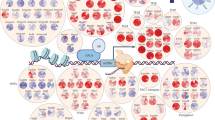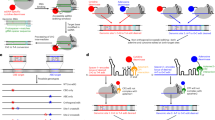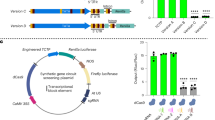Abstract
Inefficient nuclear transport of plasmid DNA continues to be a problem in nonviral vector-mediated gene transfer. This has made the cytoplasmic expression system an increasingly attractive idea. We have developed a new T7 RNA polymerase autogene for cytoplasmic expression containing both a CMV and a T7 promoter. The pCMV/T7-T7pol autogene does not encounter the problems associated with previously used autogenes. For instance, pCMV/T7-T7pol is easily amplified and purified from bacteria. Furthermore, the CMV promoter is used to drive the first round of synthesis of T7 RNA polymerase, thus negating the use of purified enzyme in the transfection complex. The endogenous T7 RNA polymerase produced from the CMV promoter could then act on the T7 promoter of pCMV/T7-T7pol in an autoregulatory mechanism. pCMV/T7-T7pol induces higher, more sustained levels (>7 days) of reporter gene expression than that observed with the previously used autogene pT7 AUTO 2C− or with the nuclear expression system pCMV-CAT. This seems to be due to the high levels of T7 RNA polymerase protein that are detected in cells transfected with pCMV/T7-T7pol. This vector also functions as an efficient autogene since at least 50 times more mRNA is transcribed from the cytoplasmic T7 promoter as compared with the nuclear CMV promoter in pCMV/T7-T7pol. Therefore, pCMV/T7-T7pol could replace existing autogenes for regeneration of T7 RNA polymerase and efficient target gene expression.
This is a preview of subscription content, access via your institution
Access options
Subscribe to this journal
Receive 12 print issues and online access
$259.00 per year
only $21.58 per issue
Buy this article
- Purchase on Springer Link
- Instant access to full article PDF
Prices may be subject to local taxes which are calculated during checkout






Similar content being viewed by others
References
Capecchi MR . High efficiency transformation by direct microinjection of DNA into cultured mammalian cells Cell 1980 22: 479–488
Zabner J et al. Cellular and molecular barriers to gene transfer by a cationic lipid J Biol Chem 1995 270: 18997–19007
Haensler J, Szoka FC . Polyamidoamine cascade polymers mediate efficient transfection of cells in culture Bioconjugate Chem 1993 4: 372–379
Gao X, Huang L . Cytoplasmic expression of a reporter gene by co-delivery of T7 RNA polymerase and T7 promoter sequence with cationic liposomes Nucleic Acids Res 1993 21: 2867–2872
Dunn JJ et al. Targeting bacteriophage T7 RNA polymerase to the mammalian cell nucleus Gene 1988 68: 259–266
Elroy-stein O, Moss B . Cytoplasmic expression system based on constitutive synthesis of bacteriophage T7 RNA polymerase in mammalian cells Proc Natl Acad Sci USA 1990 87: 6743–6747
Chen X et al. A novel nonviral cytoplasmic gene expression system and its implications in cancer gene therapy Cancer Gene Ther 1995 2: 281–289
Deng H, Wolff JA . Self-amplifying expression from the T7 promoter in 3T3 mouse fibroblasts Gene 1994 143: 245–249
Dubendorff JW, Studier FW . Creation of a T7 autogene. Cloning and expression of the gene for bacteriophage T7 RNA polymerase under control of its cognate promoter J Mol Biol 1991 219: 61–68
Chen X et al. Cancer gene therapy by direct tumor injections of a nonviral T7 vector encoding a thymidine kinase gene Hum Gene Ther 1998 9: 729–736
Gao X, Jaffurs D, Robbins PD, Huang L . A sustained, cytoplasmic transgene expression system delivered by cationic liposomes Biochem Biophys Res Commun 1994 200: 1201–1206
Studier FW . Use of bacteriophage T7 lysozyme to improve an inducible T7 expression system J Mol Biol 1991 219: 37–44
Elroy-stein O, Fuerst TR, Moss B . Cap-independent translation of mRNA conferred by encephalomyocarditis virus 5′ sequence improves the performance of the vaccinia virus/bacteriophage T7 hybrid expression system Proc Natl Acad Sci USA 1989 86: 6126–6130
Gao X, Huang L . A novel cationic liposome reagent for efficient transfection of mammalian cells Biochem Biophys Res Commun 1991 179: 280–285
Sorgi F, Huang L . Large scale production of DC-chol liposomes by microfluidization Int J Pharm 1996 144: 131–139
Farhood H, Serbina N, Huang L . The role of dioleoyl phosphatidylethanolamine in cationic liposome mediated gene transfer Biochim Biophy Acta 1995 1235: 289–295
Sambrook J, Fritsch EF, Maniatis T . Purification of closed circular DNA by equilibrium centrifugation in CsCl-Ethidium Bromide Gradients. In: Ford N, Nolan C, Ferguson M (eds) . Molecular Cloning: A Laboratory Manual, 2nd edn Cold Spring Harbor Laboratory Press: New York 1989 1.40–1.47
Sankaran L . A simple quantitative assay for chloramphenicol acetyltransferase by direct extraction of the labeled product into scintillation cocktail Anal Biochem 1992 200: 180–186
Author information
Authors and Affiliations
Rights and permissions
About this article
Cite this article
Brisson, M., He, Y., Li, S. et al. A novel T7 RNA polymerase autogene for efficient cytoplasmic expression of target genes. Gene Ther 6, 263–270 (1999). https://doi.org/10.1038/sj.gt.3300827
Received:
Accepted:
Published:
Issue Date:
DOI: https://doi.org/10.1038/sj.gt.3300827
Keywords
This article is cited by
-
A T7 autogene-based hybrid mRNA/DNA system for long-term shRNA expression in cytoplasm without inefficient nuclear entry
Scientific Reports (2019)
-
Rescue of recombinant Newcastle disease virus: current cloning strategies and RNA polymerase provision systems
Archives of Virology (2017)
-
Cloning and identification of frc gene from Oxalobacter frmigenes
Journal of Huazhong University of Science and Technology (2007)
-
Plasmid Engineering for Controlled and Sustained Gene Expression for Nonviral Gene Therapy
Pharmaceutical Research (2006)
-
Investigation of factors responsible for cell line cytoplasmic expression differences
BMC Molecular Biology (2005)



